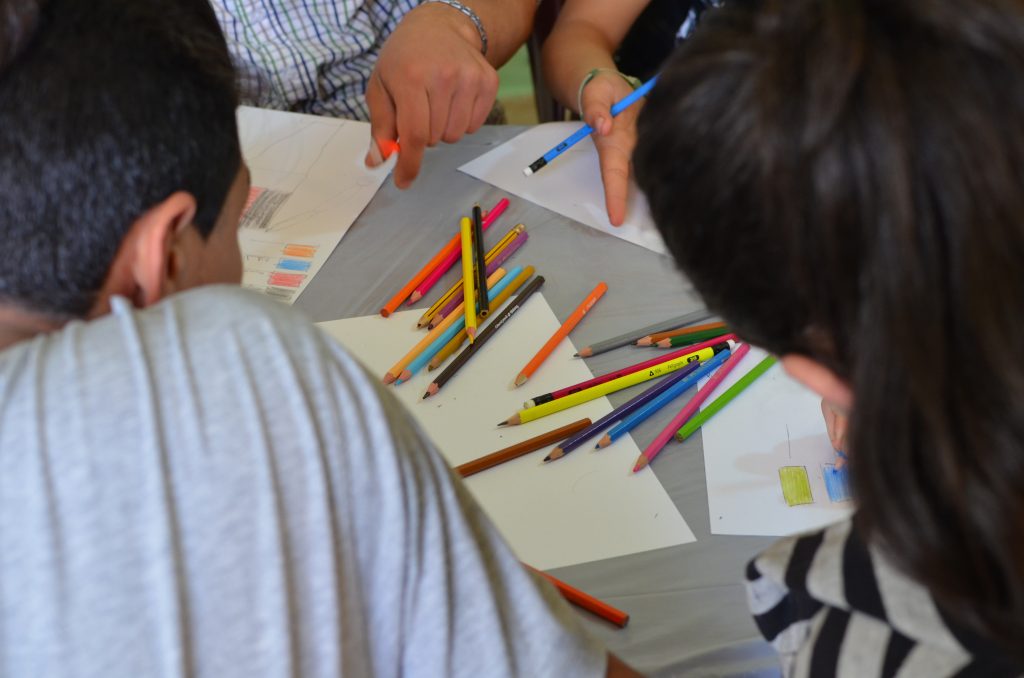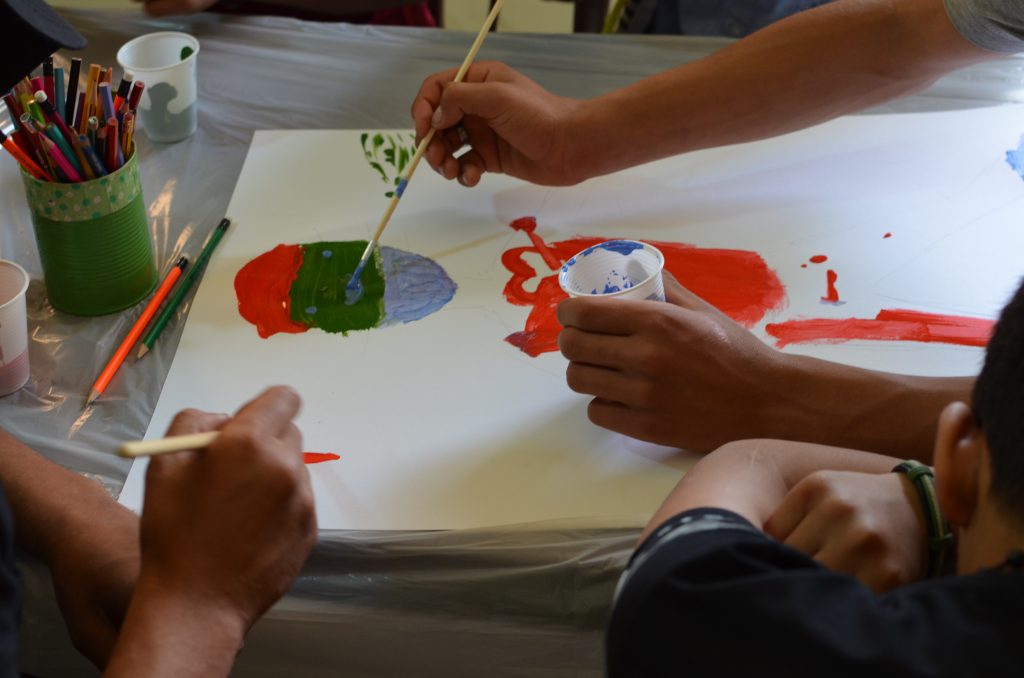Crafting an alternative Syria
Art recreates what was lost in the war
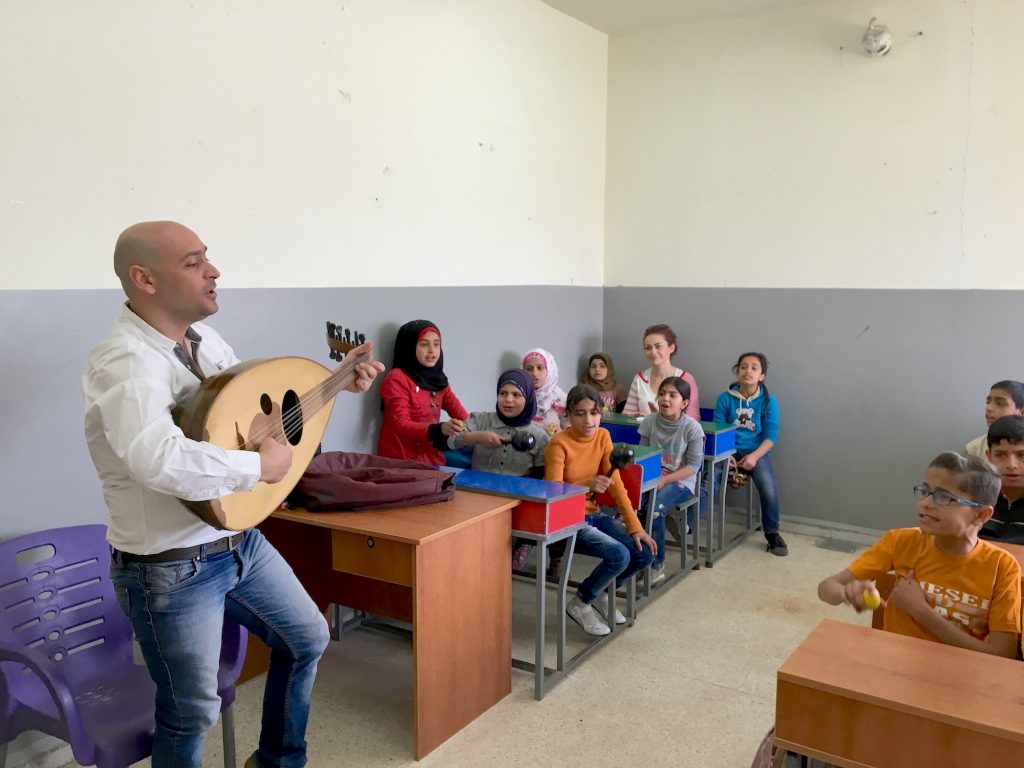
In classrooms across Lebanon, Syrian artists use painting, theatre and music to convey the sound, feel and sense of identity of Syria to a new generation, born or brought up as refugees in Lebanon.
When Maxcim Aldahouk pulls the strings of his oud, the tunes vibrating from inside the instrument are hard to hear. They are drowned by the sound of children, clapping to the rhythm and enthusiastically singing along to the famous Aleppo song Qarrasiya, meaning “dried plums”. Its lines are heavy, speaking about injustice and the eternal drama of life and love. “Being far away from my love is not okay, I want my love to stay by my side all day and all night”, the lyrics say. The children in the classroom, all from Syria, know the words by heart. It is here, in the non-formal learning center Bara’em Al-Mustaqbal, set up in the Bekaa Valley by the NGO Sawa for Development and Aid, that they have learned them.
“For the parents, Syria is a mother. But for the children, it is just pictures.”
The center is located in the town of Bar Elias, only 13 kilometers away from the Syrian border. About 110,000 Syrians live here now, in 72 settlements. Many families have been here for years – some of the children in the classroom were born here, and the only home they know is these tents.
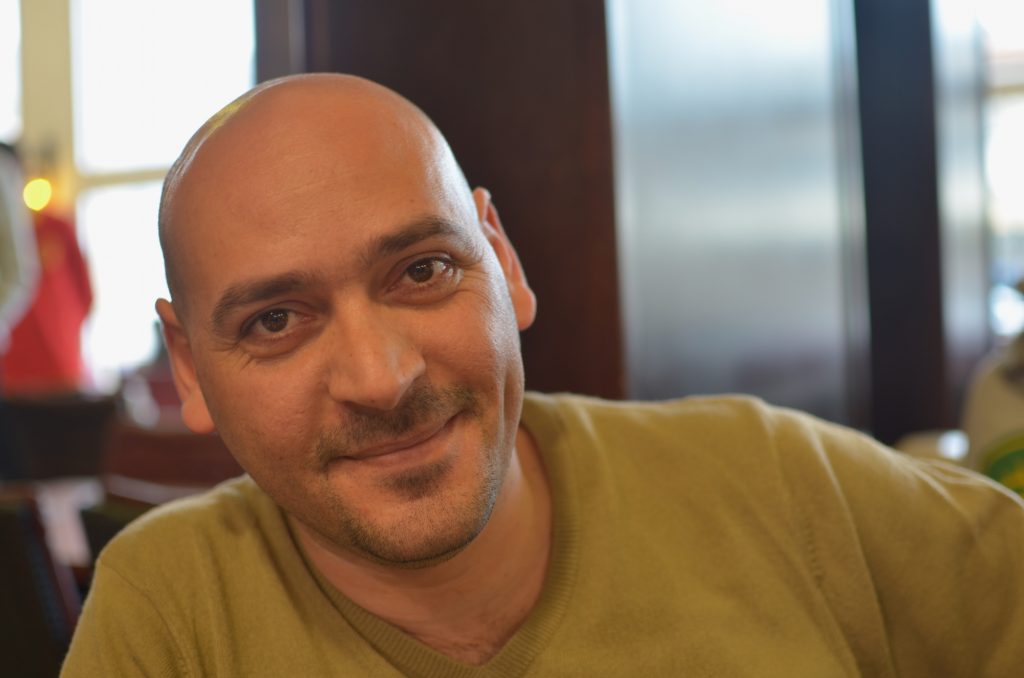
“For the parents, Syria is a mother. But for the children, it is just pictures,” says Aldahouk, a 36-year old musician from Sweida in Syria’s southeast, who studied music at the Damascus Institute for Musical Studies and now plays in a band, besides giving lessons to the children in Bar Elias. He tries to fill the blurry pictures they have of Syria with life, giving them in that way a sense of home. “We try to make a link between them and their country through folklore traditions and music,” he says.
In schools across Lebanon, Lebanese students now share the classrooms with Syrian children. Since the need for schooling is so big, separate places have also been set up specifically for Syrian students, often by different NGOs. In one of Sawa’s classrooms, children fill in the names on maps of the countries of the Levant, solve math problems in Arabic and learn rules for English plurals. But they also sing, paint and do theatre. Art, in this school, is more than just entertainment – it is also a means for the children to express their Syrian identity.
“When I reached a little girl, she said, ‘I am Maryam. I am from Abboudieh.’ But I told her: ‘You are not from Abboudieh, that is a camp’.”
For Aldahouk, playing the oud is a way to evoke feelings of home and belonging. Music, not only for artists like him but also for Syrian children, has become a way to maintain a connection to their country.
“Nobody can live without belonging. We are social beings and part of a community. We can be elsewhere than in our original society, but we take it with us [when we go],” says Aldahouk.
“We have to make [the children] feel that they still belong to the place where they come from. That they have origins, roots. The music reminds them of their country, the words relate to their social environment.”
Once, Aldahouk started his session with the kids by asking them what their names are and where they come from. “When I reached a little girl, she said, ‘I am Maryam. I am from Abboudieh.’ But I told her: ‘You are not from Abboudieh, that is a camp’,” says Aldahouk. “She is less than six years old and feels like the camp is her home. That hurts me. I told her, ‘You are from Syria. You have a country and hopefully you will go back’.”
In Lebanon, most Syrian refugees live below the poverty line, many in bad conditions in informal tent settlements across the country. Lebanon is not recognising any formal camps so settlements form arbitrarily, some on private land and others on the sides of the roads. Most are built by tarpaulin and wood trusses: too hot in summer and icy cold in winter. In these tents, families have limited or no access to water and other facilities, and no sense of privacy and security whatsoever. Many children have lost three, four, or even five years of school, and are traumatised from having lost loved ones and seen horrifying things in Syria.
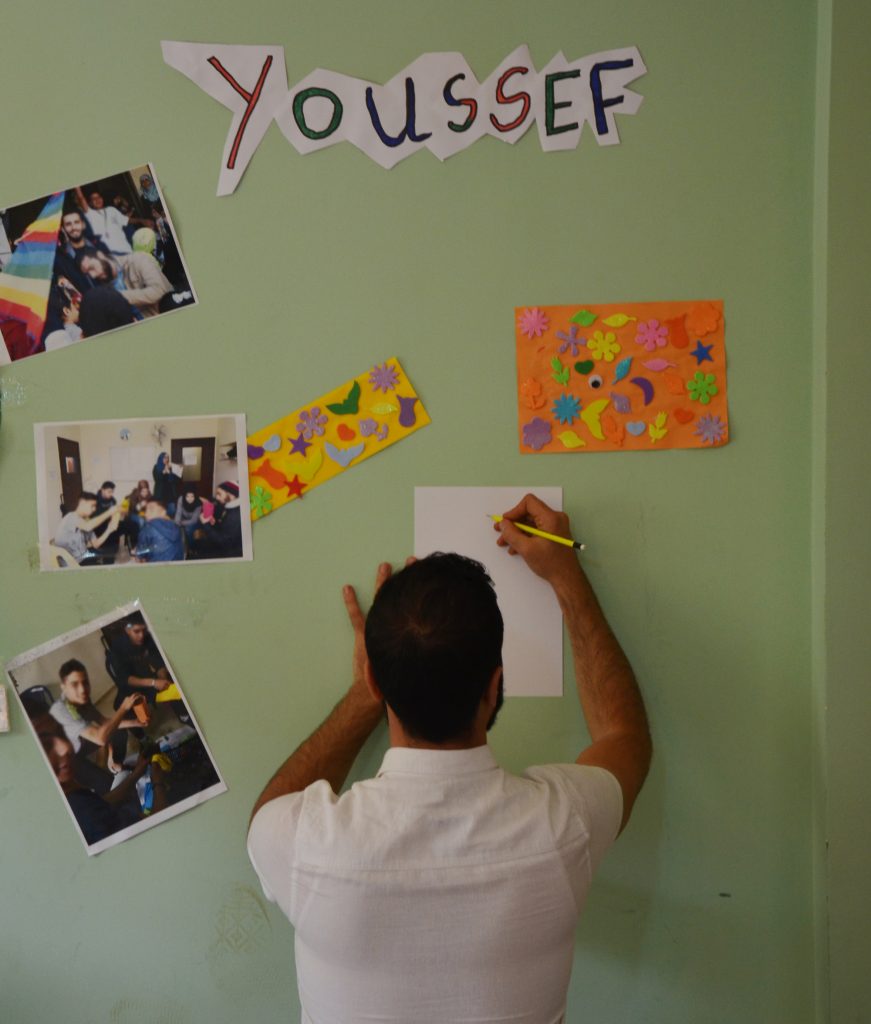
Far from the vast fields of the Bekaa, on the northern Lebanese coast, is Tripoli, the country’s second largest city. It has a long history of being a trading and cultural meeting point, and a still preserved urban heritage. In recent years though, the city has also grappled with widespread poverty and resurfacing conflicts.
Youssef Youssef, a 27 years old actor from Homs, has been living in Tripoli for three years, working with children in the Miniara and Halba camps in Tripoli and Akkar, just north of the city. Through drawing and theatre, Youssef speaks with the children about individual identity and the relationship they have with their bodies.
In the classroom of Basmeh & Zeitooneh, another NGO, Youssef puts on the soundtrack to the film Amélie, by French musician Yann Tiersen. The music was chosen by a psychologist for relaxation purposes, and as the children got used to listening to it, they now always ask for him to play it. Youssef hands out colouring pencils and acrylic paint, for them to draw and “unblock their expressions and ability to voice their feelings”. Green, for example, for sadness; orange for joy.
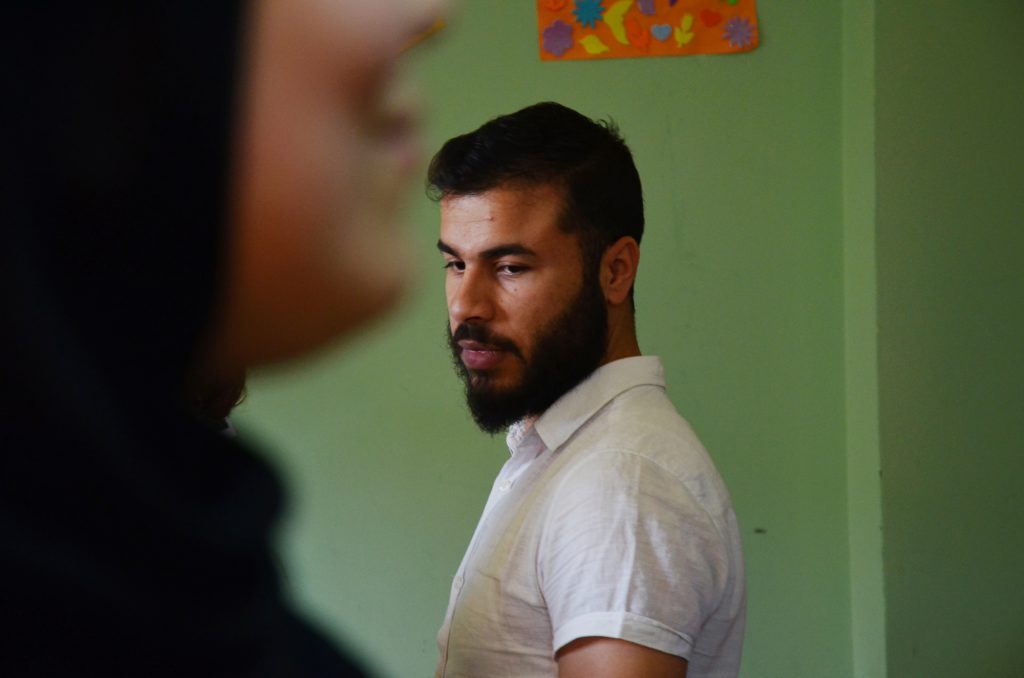
What Youssef wants is that none of these children forgets Syria, even though for some of them the country has become mostly a synonym of war. “An ugly place they do not want to get back to,” he says. He asks the kids to tell stories related to their memories: “What did you feel?” he asks, “What exactly happened?” In a session called Nostalgia, he asks them to remember something from the place where they used to live.
“Children mainly express their nostalgia for things they have left behind in Syria,” he says. The teddy bear, bicycle or olive tree in the backyard of their house back home.
While Youssef works to build children’s individual identities, 32-year old Bashar, who wants to use his first name only, tries to re-formulate a collective Syrian identity. He collects pieces of art and stories related to Syria for the website Syrian Creative Memory, aiming to preserve the country’s creativity and memory in times of conflict. For Bashar, there is no shared collective Syrian identity anymore – the segregation of Syrians and their families, their displacement and the emergence or strengthening of different political affiliations have all made it a hollow concept.
“The artistic and cultural collective memory [we had] has shifted due to the revolution. It has split into several collective memories,” he says. “Art is now very much affected by the events that the artists have witnessed: the destruction of cities and the breaking up of families. They are transferring a new identity now, but it is a display of agony, misery and pain.”
“I really don’t want the children’s perspectives to be limited to the tents they live in.”
So working with these dark and painful expressions of art and identity, can that do harm to the children?
No, says Bashar. The artists working with children focus on feelings of belonging and community, even while they may express the experience of violence in their own work. Belonging, says Bashar, does not necessarily need to come from the Syrian community. The society where they live – Lebanon – is also a crucial factor in forming their identities.
“The things that Syrians had in common are also affected and many times reshaped by their presence in a foreign country as refugees,” says Bashar.
Youssef, the actor in Tripoli, also integrates the feeling of belonging into his work. “I really don’t want the children’s perspectives to be limited to the tents they live in,” he says. “We are currently in an emergency and cannot stress the concept of rehabilitation, or planning for the future. At the current stage, it is enough for me to make the child believe that it has a hometown.”
Sometimes, Youssef asks the children about things they miss from their homes in Syria, which they then recreate in clay. The craft helps them to tell others about their stories and experiences.
“At the current stage, it is enough for me to make the child believe that it has a hometown.”
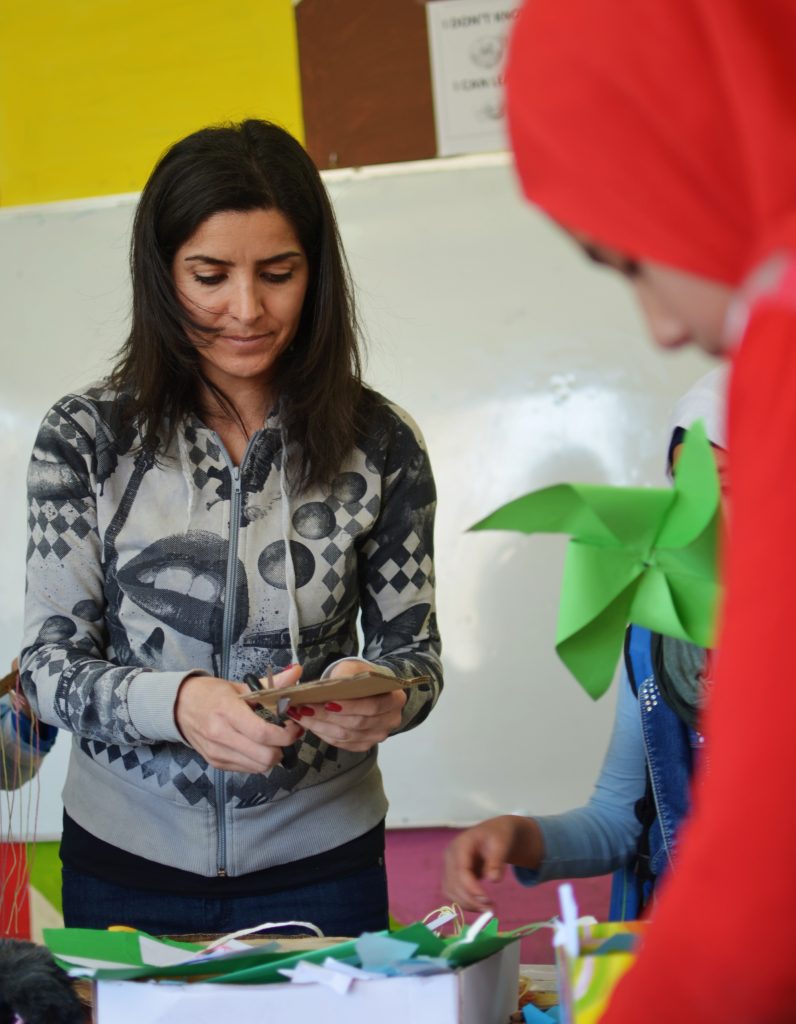
Back in the Bekaa Valley, at the school where Aldahouk plays the oud, children do exactly that: recreate through craft what they remember from Syria. They build small towns and cities, using bits of newspaper and glue. At an orange table in the front of the classroom, two girls are brushing the white liquid on shreds of newspaper, then sticking them together to form a vase of papier-maché.
Sculptor and art instructor Rouba Troudi, who comes from the province of Sweida, works with the children on traditional Syrian items: a bulgy vase with a funnel-shaped head for provisions, a Damascene sword, the famous Homs clock tower or the water wheels of Hama. She makes the older kids describe specific streets and alleys to their classmates, giving them a sense of being back in one of these Syrian towns. Then, the children use material like plastic bottles or magazines, to replicate the memorised places and objects.
“Being physically and geographically there would be the best way to remember Syria,” says Troudi. “No matter how much I tell you about Syria or the cities there, you will still miss a lot of details. No matter how much we try, we can only help children draw an image in their minds of their cities, traditions, houses and streets.”
Does the constant nostalgia, the talk about home as a place that one cannot visit, feel and smell, have a negative impact on the child?
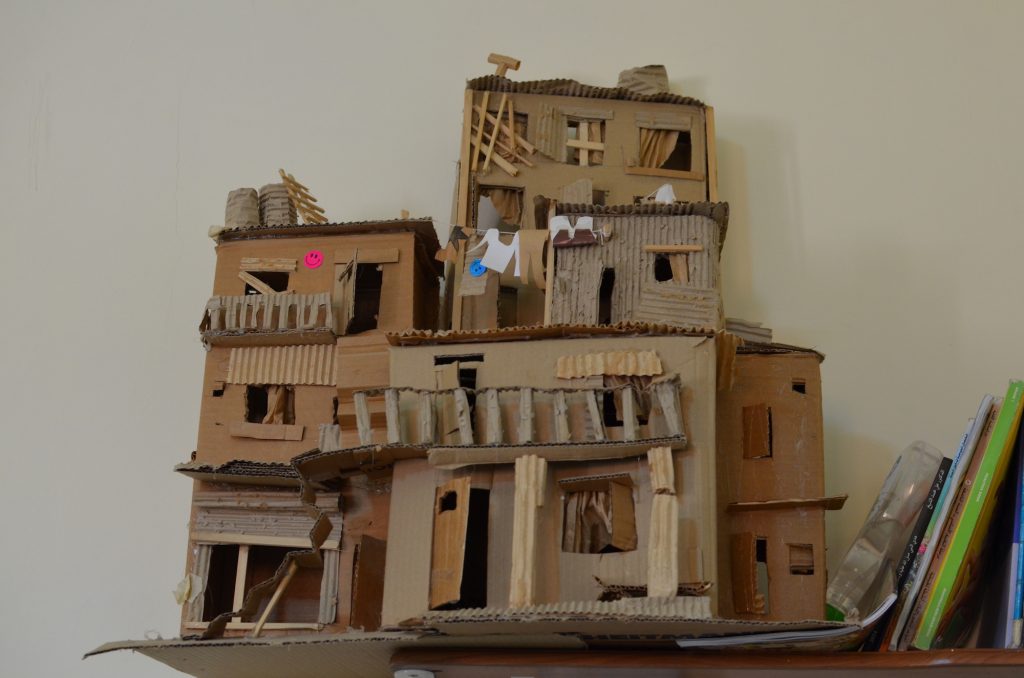
What about the kids who do not have this remembrance? Those who are born in Lebanon, or those who can only remember a few things. Does the constant nostalgia, the talk about home as a place that one cannot visit, feel and smell, have a negative impact on the child?
Bashar from Syrian Creative Memory says teaching children arts and identity does not hinder their integration. ”It is only an attempt to preserve the culture and heritage. When you teach a child about identity and heritage it does not equate actually being there or living those traditions.”
In order to give children a balanced sense of maintaining links to Syria while also feeling at home in Lebanon, Aldahouk combines teaching Syrian songs with lessons about music in general. “So that they learn about other cultures,” he says. He also teaches the children the specific quick rhythm of Arab folklore music, and common regional traditions. On his repertoire are songs of Egyptian master Abdel Halim Hafez, and the ever-loved Lebanese artist Fairuz. “There are even some of these kids who do not know Fairuz. I feel it is a duty for me to teach them about classical and reputed artists, singers that brought a lot to music with their melodies and ways of singing,” he says.
“I try to convince the children this. That even in Lebanon, you are able to make a change, using pen and paper. You can then go back to Syria and be a changemaker.”
This way – through singing folklore, building papier-maché and painting with acrylic colours – an alternative Syria is being created, not only by artists from the Syrian community, but also by children, who build the foundations from their own experiences and dreams. When recycling from magazines, cans or old plastic items, the kids make use of their inner feelings to rebuild what has been lost.
“I try to convince the children this. That even in Lebanon, you are able to make a change, using pen and paper. You can then go back to Syria and be a changemaker. You are able to rebuild. You can become a leader,” says Youssef.
This article is part of the Web Arts Resistances project in collaboration with Babelmed, Inkyfada, ONORIENT, Radio M and Tabasco video.








